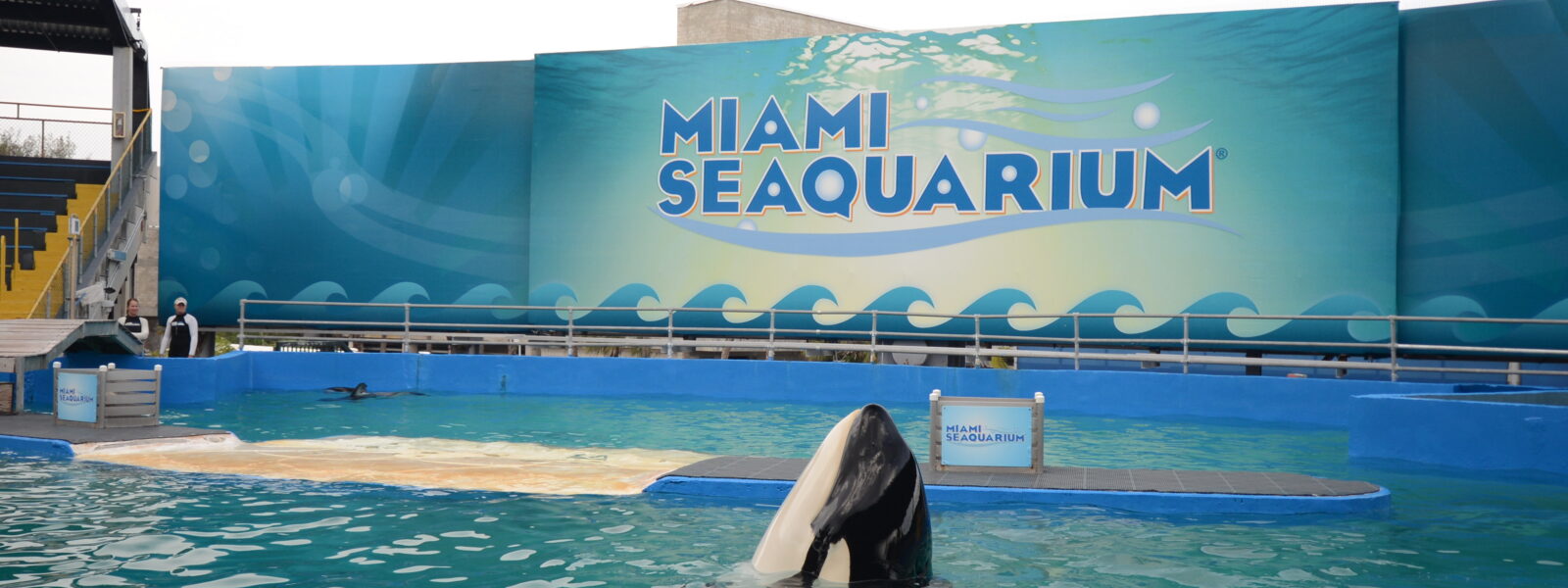
Something Rotten at the Miami Seaquarium
Photo by Dr. Ingrid Visser, Orca Research Trust
By Mark J. Palmer
A shocking government inspection report has just surfaced claiming the Miami Seaquarium fed rotten fish to its dolphins and prized orca Tokitae (also know as Lolita), the second oldest orca in captivity.
The report also documents the deaths of five dolphins and a sea lion at the Seaquarium in just one year – several of the bottlenose dolphins were apparently killed by their tank mates. Additionally, the report highlights peeling paint and exposed concrete in tanks, poor water quality, and numerous instances when food was cut from the animals’ diets over the objections of veterinarians.
The report from June 8th, 2021, written by staff of the US Animal and Plant Health Inspection Service (APHIS), part of the Department of Agriculture, is best summarized by the headline in the Miami Herald: “Dolphin fights, rotting food. Fired vet, new federal report detail problems at Seaquarium.”
The Miami Seaquarium became world famous in the 1960s with the popular television show Flipper, which was filmed on the Seaquarium grounds and featured five different captive dolphins who played the role of Flipper. They also obtained two orcas, one of which, a male called Hugo, died in 1980 from repeatedly ramming his head into the side of the concrete tank.
Since Hugo’s death, the aging female orca Tokitae has been alone in her tank, except for companion dolphins, and forced to perform for the crowds on a daily basis. Tokitae was born around 1966 in the wild and was captured in 1970 in the Pacific Northwest – she is part of the Southern Resident orca population that has been declared endangered.

Tokitae (Lolita) is the oldest captive orca in the world, held in inadequate and apparently deteriorating conditions. Photo by Dr. Ingrid Visser, Orca Research Trust.
Among the shocking revelations of the inspection report:
- Over the objections of veterinarians, Tokitae and dolphins were fed capelin that smelled badly and sickened the orca and dolphins. Furthermore, again over objections from the vets, Tokitae’s food rations were lowered by trainers. “The decisions to decrease Toki’s (food) base and continue to feed poor quality capelin to park animals were subsequently made without the AV's (Attending Veterinarian’s) approval.”
- Water quality testing by the veterinarians “observed several species of parasites – nematodes, arthropods, and other unidentified species.” Trainers reported increased symptoms in suffering dolphins such as “twitching, chuffing, and self-mutilation (rubbing etc.).”
- Several dolphins have died with signs of trauma from being rammed by fellow dolphins. Yet, the Seaquarium’s Facility Coordinator told the inspectors “that they do not have a way of tracking which animals are housed together on a particular day,” which could help keep aggressive tank mates separate and prevent them from attacking each other.
- Peeling paint chips were reported “located directly above the pool so that chips/flakes fall into the pool as they dislodge.” Dolphins reportedly brought pieces of paint over to their trainers.
- “(S)everal marine mammal pools lacked sufficient shelter to protect the animals from direct sunlight.” Several dolphins and the orca Tokitae had eye lesions, possibly due to sunlight damage and/or chlorine concentrations.
- “The facility’s attending veterinarian’s recommendations regarding the provision of adequate veterinary care and other aspects of animal care and use have been repeatedly disregarded or dismissed over the last year.” That veterinarian was fired by the Seaquarium around the time of the June inspection.
Dr. Naomi Rose, Marine Mammal Scientist with the Animal Welfare Institute, stated: “Last week, I received a USDA (US Department of Agriculture) inspection report, for an inspection done in early June, for the Miami Seaquarium. It is, without equivocation, one of the worst inspection reports I have ever seen for a US marine mammal facility.”
This inspection report comes out on the heels of revelations of the death of one beluga whale and sickness of a second that were imported in May from Canada by the Mystic Aquarium in Connecticut. SeaWorld and Loro Parque Zoo, the Canary Islands dolphinarium that houses several orcas originally from SeaWorld, have also had several captive orcas die recently, including the youngest orca held in captivity at SeaWorld, Amaya, only six years old.
Captivity kills.
Unfortunately, we expect limited compliance by the Seaquarium and hold little hope that APHIS, a government agency with a poor enforcement history, will strongly address cited health and safety concerns and hold the Seaquarium accountable. The agency, responsible for humane treatment and health of farm livestock and for killing predators to protect livestock, is ill-suited to deal with marine mammals in captivity.
In fact, in 1994, the captivity industry succeeded in convincing Congress to switch inspections of dolphinariums from the US National Marine Fisheries Service to APHIS in the Department of Agriculture for the very purpose of weakening oversight.
The International Marine Mammal Project of Earth Island Institute strongly condemns keeping dolphins and orcas in concrete tanks, and we will push for further investigations and enforcement at the Miami Seaquarium and other captive holding facilities.
Please help captive orcas and dolphins with a generous donation! The International Marine Mammal Project is dedicated to ending captivity, retiring orcas and dolphins to seaside sanctuaries, and ending captive breeding and cruel live-captures of whales and dolphins. Your donations make the difference! Thank you!
